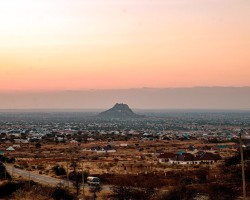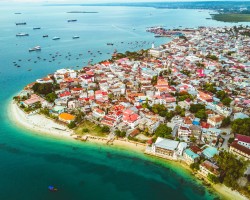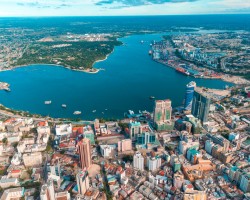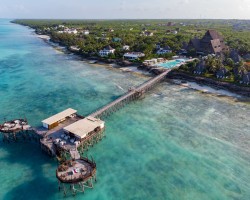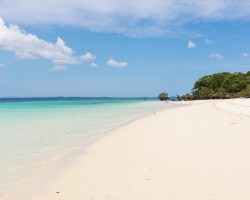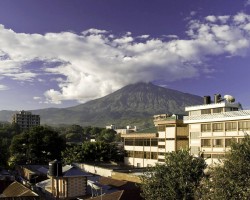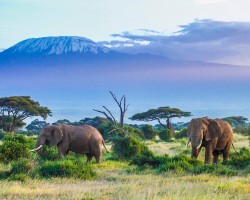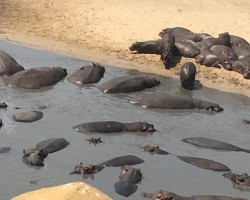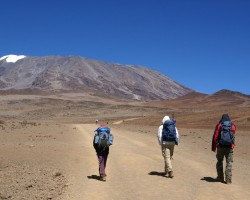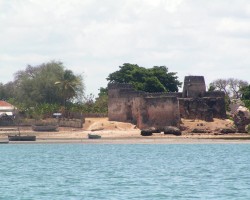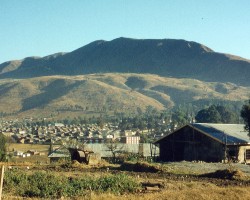Best time to go to Tanzania for a perfect weather and where to go?
When is the best time to go to Tanzania?
The best time to visit Tanzania is during the dry season which occurs twice a year:
- In January and February, known as the "small dry season". It corresponds to the average tourist season, allowing you to explore the northern part of the country, the coastal area, and the beautiful beaches of the Zanzibar archipelago without the usual tourist crowds. However, in the southern highlands, it is very rainy during this period. Tanzania is a great travel option if you want to escape the winter greyness of Europe, soak up the warmth, and feast your eyes! To top it off, this is when the great migration takes place in the plains of the Serengeti National Park. 1.5 million herbivores travel nearly 1000 km in search of fresh water.
- From May to November, it is winter in Tanzania. Since the country is located below the equator, the seasons are reversed compared to Europe. It hardly ever rains and the temperatures are not too hot. During this whole period, it is advisable to book accommodations in advance, as most hotels are fully booked. The only downside is that May is still rainy in Zanzibar and the Lake Victoria region. If you plan to visit, it's better to wait for the sunny days from June onwards. From July to September, it is the peak tourist season, with August being the busiest month. When is the best time to visit Tanzania for a quieter experience? Opt for June and November, equally pleasant weather-wise but quieter and more affordable.
Apart from the weather, these two dry seasons are ideal for an unforgettable safari. Indeed, in the Serengeti, Arusha, or Lake Manyara national parks, the vegetation is low, which enhances observation, and the animals are often gathered around water points, offering visitors a magical spectacle.
The rest of the year, only April is really not recommended due to torrential rains. Those seeking an authentic and less crowded travel experience can consider visiting Tanzania in March, during the low season. In December, holiday festivities drive prices up, but it's a good time to explore the central or northeastern part of the country.
Where and when to go based on the weather?
Central of Tanzania
Dodoma, Tabora, Singida...
Coastal Zone of Tanzania
Dar Es Salaam, Mtwara, Kilwa Masoko...
Lake Victoria Region
Serengeti National Park, Bukoba, Mwanza...
Northeast of Tanzania
Arusha, Kilimandjaro, Tarangire National Park...
Southern Highlands Zone
Mbeya, Songea, Ruaha National Park...
West of Tanzania
Mahale Mountain National Park, Katavi National Park, Gombe National Park...
Zanzibar
Stone Town, Nungwi (Unguja Island), Wete (Pemba Island)...
To get all the information about the climate and weather in Tanzania for a specific month, click on the corresponding link below:
Tanzania in january Tanzania in february Tanzania in march Tanzania in april Tanzania in may Tanzania in june Tanzania in july Tanzania in august Tanzania in september Tanzania in october Tanzania in november Tanzania in december
Best time to travel to Tanzania by cities
Climate and Weather in Tanzania
The climate in Tanzania is mostly tropical savanna with a dry winter, especially in the capital, Dar Es Salaam, and along the coast. However, as the country is vast and located between Kenya, Uganda, Zambia, and Mozambique, there are many variations depending on the regions. The weather in Tanzania, for example, will be very different if you are at Kilimanjaro or in Bukoba.
In general, it is hot all year round in Tanzania, and the closer you get to the Indian Ocean coast, the higher the temperatures, even very high. Inland, the temperatures are more moderate. As for precipitation, rains can occur even in the dry season but are short-lived.

Climate in northeastern Tanzania
It is in the north of the country that you will find major national parks such as Serengeti or Manyara. It is the only region where the climate is favorable all year round!
During the austral winter, between May and September, temperatures are cooler, even cold around Kilimanjaro in July and August. If you plan to climb it, be aware that temperatures can be icy as you approach the summit and snow is present. Elsewhere, this is the best time to enjoy the natural beauty of the parks under a prevalent blue sky.
It is between November and March that it is hottest, with highs around 30°C. Showers are not uncommon during this period, but are generally short-lived.
Climate in the coastal area and Zanzibar
On the eastern coast of Tanzania, the climate is mostly tropical savanna with a dry winter. The humidity in the air is particularly high, making it hot and stifling all year round. It rains regularly between November and May, with very rainy weather in March and April as rain falls on average 20 days per month. The best time to explore the region is during the austral winter, between June and September. Temperatures are slightly lower, ranging from 27 to 29°C, and it hardly rains.
In the Zanzibar archipelago, the climate is more monsoon tropical and precipitation intensity is similar to the coastal area. It is particularly hot, with temperatures frequently exceeding 30°C between November and May. Moreover, the air is rich in humidity, peaking in April where the risk of rain approaches 80%. The weather becomes milder with the arrival of trade winds from the Indian Ocean, from June to September.
Climate in central Tanzania
The central region of the country has two climatic zones: a tropical savanna with a dry winter climate around Tabora and a hot and dry steppe climate towards Dodoma.
In general, rain is less prevalent than elsewhere: the rainiest period extends from December to March, but there are only an average of 13 rainy days per month and they never last long.
In terms of temperatures, the thermometer shows averages between 27 and 30°C from December to June, then heat peaks between July and November where it can reach nearly 35°C.
Climate in the southern highlands and west
Unlike the rest of Tanzania, the southern highlands experience very intense rainy season between December and March. It rains almost every day and temperatures are among the lowest in the country, with lows around 22°C. Coupled with the ambient humidity, the sensation of coolness can be very unpleasant.
Between April and November, it is a good time to explore this part of the country. From May to August, temperatures range from 21 to 27°C and rain is almost non-existent. Between September and November, the atmosphere warms up with temperatures around 30°C.
In the west, the rainy season is slightly less pronounced, but the period between November and April should still be avoided for optimal travel conditions. Prefer the months between May and October: rains are rare and the weather is pleasant with lows around 24°C and highs not exceeding 30°C.
Climate in the Lake Victoria region
The best time to visit the region is during the austral summer, in January and February, as well as during winter, from June to September. The month with the best weather conditions is July, as this is when rainfall is lowest and temperatures are perfect: 24°C at night and around 30°C during the day. The rest of the time, the Lake Victoria region experiences abundant and very frequent rains, with up to 22 rainy days in April.
Temperatures and rainfall in Tanzania
On these 3 graphs, we present the evolution of temperatures of Tanzania and month-by-month rainfall for the cities of Dodoma, Stone Town, Dar Es Salaam, Serengeti National Park and Nungwi (Unguja Island), as well as the month-by-month sea temperature for coastal cities.
Peak visitor numbers and tourist seasons in Tanzania
Find out when Tanzania has its high tourist season (the period when the influx of tourists is highest) and off-peak tourist season using our data and figures.
Tourist seasons in Tanzania
The months with low numbers of tourists are: January, February, March, April, May, June and November. The number of visitors to Tanzania is high in: July, August, September, October and December.
- Very low season in Tanzania: March, April and May.
- Low season in Tanzania: January, February, June and November.
- High season in Tanzania: September and October.
- Peak season in Tanzania: July, August and December.
Figure: Visitor index for Tanzania month by month
Average price for flights to Tanzania
A return flight between London and Zanzibar is generally cheaper if you go in march ($ 714 on average): this is the best time for travellers on a tight budget. In contrast, you may end up paying $ 465 more for your airline ticket to Zanzibar if you go in august.
Find the best price for your flight Flight prices to Tanzania
Where to go in Tanzania?
This table allows you to see the maximum temperature for each city and our opinion on the weather month by month (see colour legend below the table).
| Cities | jan. | feb. | mar. | apr. | may | jun. | jul. | aug. | sep. | oct. | nov. | dec. |
| Dodoma | 29°C | 29°C | 29°C | 28°C | 28°C | 28°C | 28°C | 29°C | 31°C | 33°C | 33°C | 31°C |
| Stone Town | 30°C | 30°C | 31°C | 30°C | 29°C | 28°C | 27°C | 27°C | 28°C | 29°C | 30°C | 30°C |
| Dar Es Salaam | 31°C | 32°C | 32°C | 30°C | 29°C | 29°C | 28°C | 29°C | 30°C | 31°C | 32°C | 32°C |
| Serengeti National Park | 28°C | 29°C | 29°C | 27°C | 27°C | 28°C | 30°C | 31°C | 31°C | 31°C | 29°C | 27°C |
| Nungwi (Unguja Island) | 30°C | 30°C | 31°C | 30°C | 29°C | 28°C | 27°C | 27°C | 28°C | 29°C | 30°C | 30°C |
| Wete (Pemba Island) | 29°C | 29°C | 30°C | 29°C | 28°C | 27°C | 27°C | 26°C | 27°C | 28°C | 29°C | 29°C |
| Arusha | 28°C | 29°C | 29°C | 26°C | 24°C | 24°C | 24°C | 26°C | 28°C | 28°C | 28°C | 28°C |
| Bukoba | 25°C | 25°C | 25°C | 24°C | 23°C | 24°C | 24°C | 24°C | 25°C | 25°C | 24°C | 24°C |
| Gombe National Park | 25°C | 26°C | 26°C | 25°C | 25°C | 25°C | 25°C | 26°C | 27°C | 27°C | 26°C | 25°C |
| Katavi National Park | 22°C | 23°C | 23°C | 23°C | 24°C | 24°C | 25°C | 27°C | 29°C | 29°C | 27°C | 23°C |
| Kilimandjaro | 30°C | 31°C | 31°C | 28°C | 26°C | 26°C | 26°C | 27°C | 29°C | 30°C | 29°C | 29°C |
| Kilwa Masoko | 30°C | 30°C | 30°C | 29°C | 29°C | 28°C | 28°C | 28°C | 29°C | 29°C | 30°C | 31°C |
| Mahale Mountain National Park | 25°C | 26°C | 26°C | 26°C | 26°C | 26°C | 26°C | 27°C | 28°C | 28°C | 26°C | 25°C |
| Mbeya | 22°C | 22°C | 22°C | 22°C | 21°C | 21°C | 22°C | 24°C | 27°C | 28°C | 27°C | 23°C |
| Mtwara | 30°C | 30°C | 30°C | 29°C | 29°C | 28°C | 28°C | 28°C | 29°C | 29°C | 30°C | 31°C |
| Mwanza | 26°C | 28°C | 27°C | 26°C | 26°C | 27°C | 28°C | 28°C | 28°C | 28°C | 27°C | 26°C |
| Ruaha National Park | 24°C | 24°C | 24°C | 24°C | 24°C | 23°C | 24°C | 25°C | 27°C | 29°C | 28°C | 26°C |
| Singida | 29°C | 29°C | 29°C | 28°C | 28°C | 28°C | 28°C | 29°C | 31°C | 33°C | 33°C | 31°C |
| Songea | 26°C | 26°C | 26°C | 25°C | 24°C | 24°C | 24°C | 27°C | 29°C | 31°C | 30°C | 28°C |
| Tabora | 27°C | 28°C | 28°C | 27°C | 28°C | 29°C | 30°C | 32°C | 34°C | 33°C | 31°C | 27°C |
Legend:
perfect weather
good weather
tolerable weather
bad weather
very bad weather
About Tanzania
What can I do in Tanzania?
Beaches / swimming
Nature and countryside
Culture and heritage
Sports
Family travel
Crafts / shopping
Gastronomy
Nightlife
Is this weather information for Tanzania reliable?
Climate data for Tanzania has been gathered every day since January 2009. The analysis of these meteorological data for Tanzania allows us to determine the average for each month in Dodoma, Stone Town, Dar Es Salaam, Serengeti National Park, Nungwi (Unguja Island), Wete (Pemba Island), Arusha, Bukoba, and 72 other cities.
So yes: this data is reliable except in cases of temporary climate disruption in the region.
